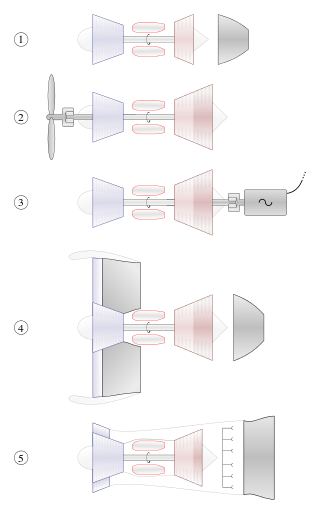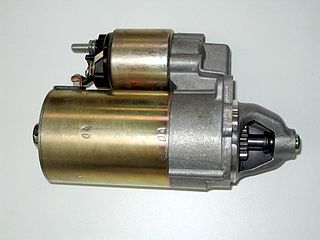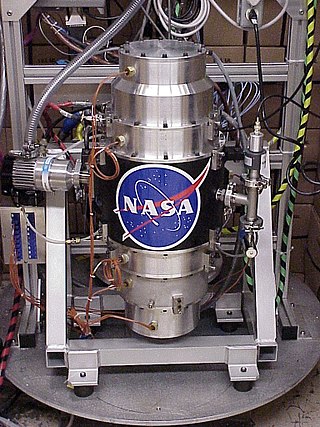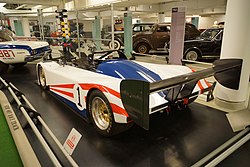
A locomotive or engine is a rail transport vehicle that provides the motive power for a train. If a locomotive is capable of carrying a payload, it is usually rather referred to as a multiple unit, motor coach, railcar or power car; the use of these self-propelled vehicles is increasingly common for passenger trains, but rare for freight.

A gas turbine, also called a combustion turbine, is a type of continuous flow internal combustion engine. The main parts common to all gas turbine engines form the power-producing part and are, in the direction of flow:

A starter is a device used to rotate (crank) an internal-combustion engine so as to initiate the engine's operation under its own power. Starters can be electric, pneumatic, or hydraulic. The starter can also be another internal-combustion engine in the case, for instance, of very large engines, or diesel engines in agricultural or excavation applications.

A hybrid vehicle is one that uses two or more distinct types of power, such as submarines that use diesel when surfaced and batteries when submerged. Other means to store energy include pressurized fluid in hydraulic hybrids.

Regenerative braking is an energy recovery mechanism that slows down a moving vehicle or object by converting its kinetic energy into a form that can be either used immediately or stored until needed. In this mechanism, the electric traction motor uses the vehicle's momentum to recover energy that would otherwise be lost to the brake discs as heat. This method contrasts with conventional braking systems. In those systems, the excess kinetic energy is converted to unwanted and wasted heat due to friction in the brakes, or with rheostatic brakes, where the energy is recovered by using electric motors as generators but is immediately dissipated as heat in resistors. In addition to improving the overall efficiency of the vehicle, regeneration can significantly extend the life of the braking system as the mechanical parts will not wear out quickly.

A diesel–electric transmission, or diesel–electric powertrain, is a transmission system for vehicles powered by diesel engines in road, rail, and marine transport. Diesel–electric transmission is based on petrol–electric transmission, a transmission system used for petrol engines.

A compressed-air vehicle (CAV) is a transport mechanism fueled by tanks of pressurized atmospheric gas and propelled by the release and expansion of the gas within a pneumatic motor.

Revolutions per minute is a unit of rotational speed for rotating machines. One revolution per minute is equivalent to 1/60 hertz.
A direct-drive mechanism is a mechanism design where the force or torque from a prime mover is transmitted directly to the effector device without involving any intermediate couplings such as a gear train or a belt.

A pneumatic motor, or compressed air engine, is a type of motor which does mechanical work by expanding compressed air. Pneumatic motors generally convert the compressed air energy to mechanical work through either linear or rotary motion. Linear motion can come from either a diaphragm or piston actuator, while rotary motion is supplied by either a vane type air motor, piston air motor, air turbine or gear type motor.
The Dodge Intrepid ESX prototype cars are the result of the 1993 response by the Chrysler Corporation to a challenge by U.S. President Bill Clinton to produce a vehicle which was capable of meeting the demands of the modern consumer, while still achieving an unprecedented 80 miles per US gallon overall in fuel economy. The PNGV - Partnership for a New Generation of Vehicles project was aimed at The Big Three American car manufacturers.
The BMW GT 101 was a turboshaft-type gas turbine engine developed from the BMW 003 aviation engine, that was considered for installation in Nazi Germany's Panther tank. The German Army's development division, the Heereswaffenamt, studied a number of gas turbine engines for use in tanks starting in mid-1944. Although none of these was fitted operationally, the GT 101 reached a production quality stage of development. Several designs were produced over the lifetime of the program, including the GT 102 and GT 103.
Hybrid vehicle drivetrains transmit power to the driving wheels for hybrid vehicles. A hybrid vehicle has multiple forms of motive power.
A hybrid train is a locomotive, railcar or train that uses an onboard rechargeable energy storage system (RESS), placed between the power source and the traction transmission system connected to the wheels. Since most diesel locomotives are diesel-electric, they have all the components of a series hybrid transmission except the storage battery, making this a relatively simple prospect.

A kinetic energy recovery system (KERS) is an automotive system for recovering a moving vehicle's kinetic energy under braking. The recovered energy is stored in a reservoir for later use under acceleration. Examples include complex high end systems such as the Zytek, Flybrid, Torotrak and Xtrac used in Formula One racing and simple, easily manufactured and integrated differential based systems such as the Cambridge Passenger/Commercial Vehicle Kinetic Energy Recovery System (CPC-KERS).

Flywheel energy storage (FES) works by accelerating a rotor (flywheel) to a very high speed and maintaining the energy in the system as rotational energy. When energy is extracted from the system, the flywheel's rotational speed is reduced as a consequence of the principle of conservation of energy; adding energy to the system correspondingly results in an increase in the speed of the flywheel.

The Porsche 918 Spyder is a sports car manufactured by German marque Porsche. The 918 Spyder is a plug-in hybrid powered by a mid-mounted naturally aspirated 4.6 L (4,593 cc) V8 engine, developing 447 kW at 8,700 RPM, with two electric motors delivering an additional 210 kW for a combined output of 652 kW (875 hp) and 1,280 N⋅m (944 lbf⋅ft) of torque. The 918 Spyder's 6.8 kWh lithium-ion battery pack delivers an all-electric range of 19 km (12 mi) under the US Environmental Protection Agency's five-cycle tests.

The Jaguar C-X75 is a hybrid-electric, 2-seat, concept car produced by British automobile manufacturer Jaguar Cars in partnership with the derivative of the Formula One team, Williams Advanced Engineering, which debuted at the 2010 Paris Motor Show. The powertrain of the C-X75 concept is rated at 778 hp through four YASA electric motors, each of which drives one of the four wheels. The batteries driving these motors are recharged using two diesel-fed micro gas turbines instead of a conventional four-stroke engine. It was described as a design study that would influence future design and technology.
Satcon Technology Corporation is an energy and power company originally based in Cambridge, and later Boston, Massachusetts. Its markets include the utility, hybrid vehicle, ship building, industrial automation, semiconductor processing, and defense.
Petrol–electric transmission or gasoline–electric transmission or gas–electric transmission is a transmission system for vehicles powered by petrol engines. Petrol–electric transmission was used for a variety of applications in road, rail, and marine transport, in the early 20th century. After World War I, it was largely superseded by diesel-electric transmission, a similar transmission system used for diesel engines; but petrol-electric has become popular again in modern hybrid electric vehicles.













